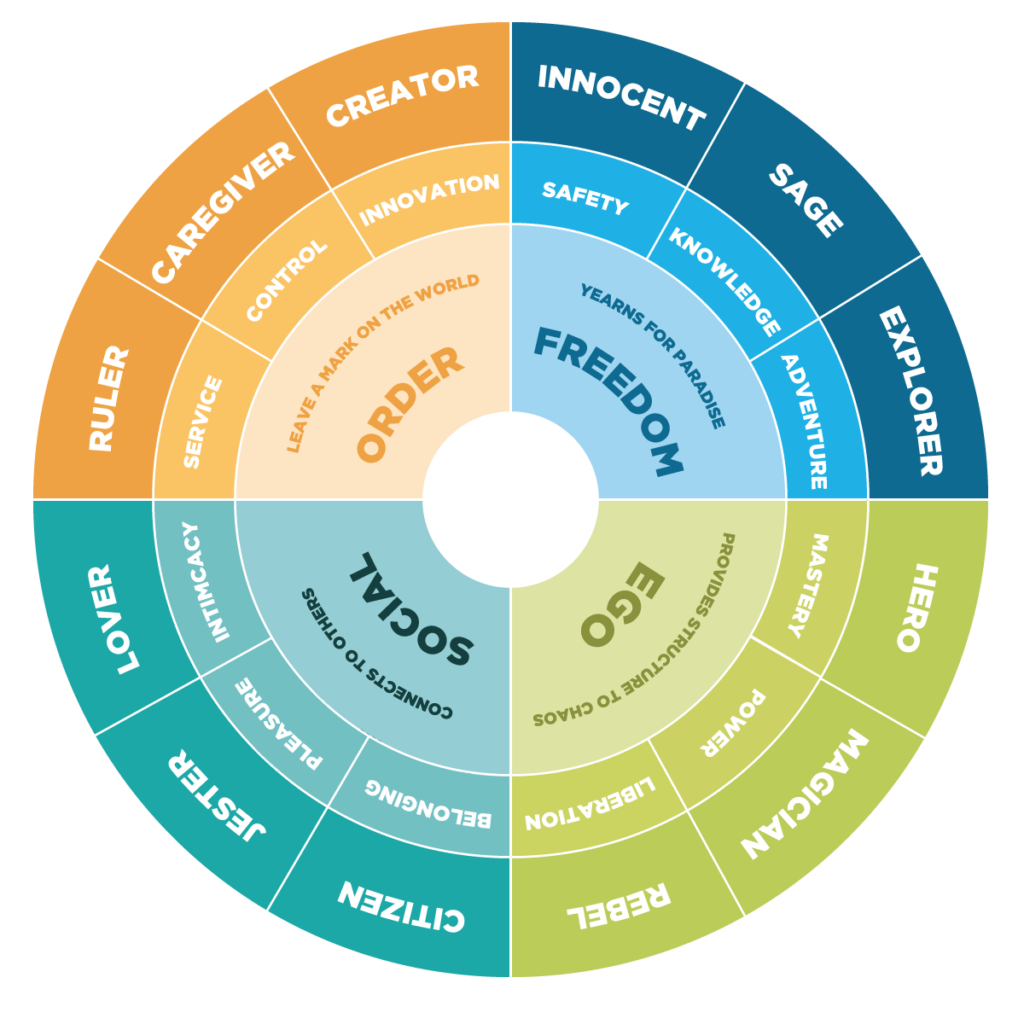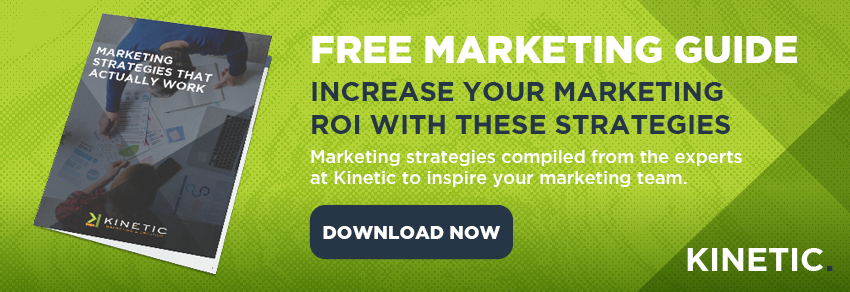The 12 Brand Archetypes
Megan Pullins Digital Director
How Do You Want The World To See You?
Or really, how do you want the world to unconsciously understand you? That is what brand archetypes are all about.
Brand archetypes are based on a philosophical theory developed by three people: An Austrian neurologist Sigmund Freud (1856 – 1939), Swiss psychiatrist Carl Jung (1875 – 1961) and an American writer Joseph Campbell (1904 – 1987).
- Around 1897, Sigmund Freud popularized the concept of the subconscious mind and wrote that humans act and are influenced by these unconscious thoughts. (Check out “The Interpretation of Dreams” for more.)
- Carl Jung took that concept and developed the collective subconscious theory around 1916. This theory is that humans are born not as blank slates but actually as understanding and processing the world in 12 specific ways. These 12 ways are called archetypes. (Add “Psychology and Religion: West and East” and “Archetypes and the Collective Unconscious” collected works to your reading list.)
- Joseph Campbell melded these 12 universal archetypes with human experiences to create metaphors for storytelling around 1949. (Read “Hero with a Thousand Faces” and “The Power of Myth” for more.)
 Today, brands can connect with their audiences on a subconscious level by aligning their brand messaging with one or a more of these archetypes.
Today, brands can connect with their audiences on a subconscious level by aligning their brand messaging with one or a more of these archetypes.
Use this 10-minute activity to pinpoint the archetypes you think best fit with your brand persona (or the persona you WANT your brand to embody). Use these insights as a framework to refer back to as you develop your messaging across the marketing landscape to solidify brand recognition on a subconscious level.

The 12 Brand Archetypes
Dive deeper into each archetype below, and review some examples of brands that personify that archetype.
Archetypes that are motivated by freedom and yearn for paradise:
The Innocent
The Innocent archetype is motivated by freedom and finds paradise in safety. Brands with the Innocent archetype are selling happiness. They want to make their audience happy. The Innocent archetype wants to be seen as reliable, trustworthy, honest, moral, pure and optimistic. Sometimes the Innocent can be nostalgic.
Examples: Aveeno, Coca-Cola, Dove, Orville Redenbacher, PepsiCo, City Brew Coffee, Daisy
The Sage
The Sage archetype finds paradise and freedom through knowledge. If the Sage had a motto it would be “the truth will set you free.” Their goal is to help the world gain wisdom and insight. They want to be seen as a knowledgeable, trusted source of information.
Examples: BBC, PBS, Google, Ellevest, MorningBrew, Philips, SEMRush, HubSpot, Lonely Planet
The Explorer
The Explorer yearns for freedom through adventure, discovery and new experiences. They are in the business of selling adventure. They support ambitious, individualistic and independent ideology. If your product is a pioneer in your industry, your brand may fit the Explorer archetype. These brands don’t want feel stuck in a cage, they want to roam free.
Examples: Jeep, Red Bull, Patagonia, REI, Black Diamond, La Sportiva, Yeti, Thule
Archetypes that are motivated by order and want to provide structure to the world:
The Ruler
The Ruler provides structure to a world with control. They believe in the best of the best and hold power on the highest pedestal. They create order from chaos and want to be thought of as a leader or role model. The Ruler can be controlling, stern, responsible, organized, efficient and productive in spirit. These brands help to restore order and stability in a chaotic world.
Examples: Microsoft, Monday.com, Barclays, Mercedes-Benz, Tesla
The Caregiver
The Caregiver provides structure through service. These brands care for and protect others. They want to be seen as caring, nurturing, selfless, generous and compassionate. Brands with a strong service culture that help people care for themselves and are in healthcare or education often have the Caregiver archetype.
Examples: Mercy, Toms, Feed the Children, Campbell’s Soup, Johnson & Johnson, Uncommon Goods, Honest Co.
The Creator
The Creator provides structure through innovation. These brands have created something that fosters expression in meaningful ways. They help customers express themselves in creative, artistic and imaginative ways. The Creator encourages and inspires originality and wants to be perceived as innovative and pushing the boundaries.
Example: Adobe, Canva, TikTok, Twitter, Lego, Crayola, YouTube, Sony, Picasso
Archetypes that are motivated socially and want to connect with others:
The Lover
The Lover connects people through intimacy. They sell passion, romance and commitment. Brands that personify the Lover archetype help people feel like they belong and are appreciated. The lover wants to inspire love and romance.
Examples: Victoria’s Secret, Godiva Chocolate, Chanel, Haagen-Dazs, Marie Claire, Yves Saint Laurent
The Jester
The Jester connects people through pleasure or laughter. These brands want to bring joy to the world and are light-hearted, mischievous, or irreverent. The Jester may be construed as disrespectful or irreverent. Brands who help people have a good time and enjoy the moment while encouraging them to live spontaneously or impulsively may have a bit of The Jester in their brand persona.
Examples: Old Spice, Dollar Shave Club, M&Ms, The Motley Fool, Ben & Jerry’s
The Regular Guy or Gal / The Citizen
The Citizen archetype connects people through belonging. These companies may be described as being down to earth, supportive, the person next door, or even folksy. Brands that have a common touch and bring people together in an unassuming way have a “Regular Guy” or the Citizen archetype.
Examples: Home Depot, eBay, Peanut, Etsy, Levi’s, Old Navy
Archetypes that are motivated by their ego and are driven to leave their mark on the world:
The Hero
The Hero archetype leaves its mark on the world through mastery. Their brand is bold, courageous, honorable, strong and confident. If your product solves a major problem or enables others to solve major problems, you might include a bit of the Hero archetype in your marketing messaging. They focus on growth and development and want to prove people wrong.
Examples: Gates Foundation, Tesla, Nike, BMW, Duracell, Logixboard, FedEx, U.S. Marine Corps
The Outlaw
The Outlaw archetype leaves its mark through liberation. These brands aren’t afraid to break the rules and fight authority. The Outlaw can be described as rebellious, wild, pioneering change, iconoclastic and an advocate for the disenfranchised. These brands are questioning authority and may have combative rhetoric in their marketing messaging. They are disruptive in a shocking way.
Examples: Vans, Diesel, Harley-Davidson, Virgin (Richard Branson), PayPal, MTV, Betsy Johnson
The Magician
The Magician archetype leaves its mark through power. These brands make dreams come true. The Magician wants to be seen as a charismatic visionary. Some may come off as idealistic or even spiritual. Companies whose products help people transform their world and inspire change in ways customers have never imagined, may have the Magician brand archetype.
Examples: Disney, Apple, Tesla, Logixboard, Mac Cosmetics, Dyson, TED, Polaroid.
The Activity
Get your team together and use the chart above to get your branding gears moving. Start from the center and move in and out to pin down the archetype that most closely embodies your brand.
The core of the circle represents what you offer your customers and represents what motivates your target audience to take action. Do you offer freedom, order, ego, or social connection? Note the characteristics that resonate with your company’s spirit, mission, values and purpose. Be authentic with your answers.
These traits will become your brand’s persona, which you can refer to when developing your marketing messages. Think about how you want your target audience to react to your campaigns as you work through this chart.
FYI: Kinetic Marketing & Creative is a full-service marketing agency that is trusted by brands around the nation. Contact us if you are ready to move your brand forward with a team of experts in branding to digital marketing. Check out a sample of our award-winning client work.
Megan Pullins
Digital Director





